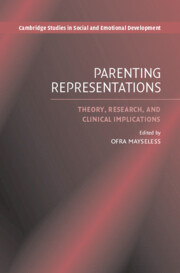Book contents
- Frontmatter
- Contents
- List of Illustrations
- List of Tables
- List of Appendixes
- List of Contributors
- Preface
- Acknowledgments
- Part One Theoretical Perspectives
- 1 Studying Parenting Representations as a Window to Parents' Internal Working Model of Caregiving
- 2 Maternal Representations of Relationships: Assessing Multiple Parenting Dimensions
- 3 Social Cognitive Approaches to Parenting Representations
- Part Two Research Applications
- Part Three Clinical Implications
- Index
- Cambridge Studies in Social and Emotional Development
- References
2 - Maternal Representations of Relationships: Assessing Multiple Parenting Dimensions
from Part One - Theoretical Perspectives
Published online by Cambridge University Press: 10 July 2009
- Frontmatter
- Contents
- List of Illustrations
- List of Tables
- List of Appendixes
- List of Contributors
- Preface
- Acknowledgments
- Part One Theoretical Perspectives
- 1 Studying Parenting Representations as a Window to Parents' Internal Working Model of Caregiving
- 2 Maternal Representations of Relationships: Assessing Multiple Parenting Dimensions
- 3 Social Cognitive Approaches to Parenting Representations
- Part Two Research Applications
- Part Three Clinical Implications
- Index
- Cambridge Studies in Social and Emotional Development
- References
Summary
Abstract
This chapter describes a series of studies using an adapted version of the Parent Development Interview (PDI) to assess dimensions of parenting in addition to attachment, such as parents' orientation towards achievement and compliance, and the business of caretaking. The results demonstrate the following points regarding maternal representations: 1) maternal representations of not only attachment, but also discipline and teaching, seem to be organized and measurable; 2) these three parenting dimensions are not redundant; 3) they relate to characteristics of the child (such as birth order, verbal IQ, disability status, and gender) and characteristics of the mother (such as age, education, income, sensitivity with her child, and psychological adjustment); and 4) they differentially predict aspects of maternal behavior, even when maternal education and psychological characteristics are taken into account. Anger, perspective-taking, and achievement were found to be particularly important dimensions of maternal representations.
Originally, Bowlby developed attachment theory to explain the nature of children's bonds to their parents in terms of their biological function, and to account for disturbing behaviors observed in infants subjected to prolonged separations from significant attachment figures (1969). With further developments in attachment theory, Main, Kaplan, and Cassidy (1985) suggested that parents' mental representations of their own childhood attachment experiences strongly influence the quality of their child's attachment to them. Mental representations, also called internal working models or representational models, are cognitive structures that develop when individuals are exposed to many similar, yet different, experiences.
- Type
- Chapter
- Information
- Parenting RepresentationsTheory, Research, and Clinical Implications, pp. 41 - 78Publisher: Cambridge University PressPrint publication year: 2006
References
- 7
- Cited by



